After transcribing Samuel Tippet’s piece with my group members, we came up with a research question that we felt was appropriate. Our research question was:
How does religion and faith play a role in Samuel Tippet’s transcription?
Tippet’s piece begins with him describing himself. He was born in 1711 in the Parish of Bitton. He also describes his family life and his challenges. His father had died when he was very young, and he turned to God during this period of hardship. Personally, I think he is a little troubled and very dark because several times throughout the pieces he “wishes he was never born” and questions himself what life would be like without him. He criticizes, and self scrutinizes himself and all of the mistakes that he has made throughout his life. Throughout the piece, he describes how he turns to God because of the mistakes he had made in his earlier life.
By asking ourselves this question, it helps the reader or transcriber understand the piece more and analyze it better. When comparing our piece (Samuel Tippet) to another piece, the research question also came into play. The research question also applied to the Esther Latrobe’s memoir.
When using Voyant, each memoir’s key terms comes up. For our piece, the key terms were heart, times, time, poor, and love. For the Esther Latrobe memoir, the key terms were lord, dear, god, let and savior which is why our research question on religion pertains to their piece as well. The combined key terms for the pieces are Lord, heart, time, dear, and oh. Using Voyant, there are many tools available that help you decipher and analyzed a piece. For our piece (Samuel Tippet), it is much shorter than the Latrobe Memoir. Samuel Tippet’s piece had a little around 4,000 words (3,806 words to be exact). In our piece, there was almost no punctuation which made the words/sentence equal to 1,268. The Latrobe’s statistics are more accurate because of the use of punctuation. It was a much longer piece with 8,460 words. The words\sentence was 24.6 which seems to make a lot more sense. Using some of the tools such as terms berry, it tells the Voyant user that the word ‘God’ was used 26 times in the Latrobe memoir. Using the bubble tool, the key words that are most frequently used are the ones with biggest bubbles which makes it easy to tell and visualize instead of just reading terms off of a list. Personally, I like the visualization tools the most because it helps me understand recognize the key terms in a piece better. Other tools such as ‘Grid Tools’ seem very standard to me and have the terms in a chart. Attached, I included a few photos of the tools I used with Voyant.




Morgan Graning is a junior at Bucknell University. She is a political science major and sociology minor. Morgan is from Long Island, New York.
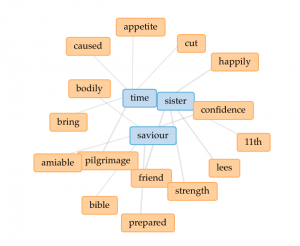
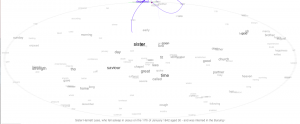
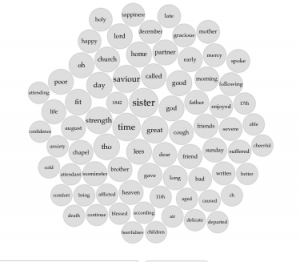
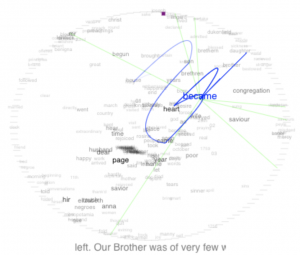 keywords throughout my document in a neat visual. This tool painted out a nice overview of the text, and “creat[ed] visual abstractions of textual patterns” (193), which I used before diving into other tools that gave more detailed data. In a way, I used this tool to see a summary of my document.
keywords throughout my document in a neat visual. This tool painted out a nice overview of the text, and “creat[ed] visual abstractions of textual patterns” (193), which I used before diving into other tools that gave more detailed data. In a way, I used this tool to see a summary of my document. word cloud emphasizes a frequently used to term by making it larger. Observing my word cloud, I was able to see that congregation, heart, saviour, son, and brethren were most frequently used. I did not find any collocates to be particularly useful because no words were associated with another more than once, so no phrases presented themselves as frequently used in the document. These words allowed me to see that Joesph Lingard’s story of how he joined congregation was more instrumental to the text than I originally thought. However, the Document Terms gives the quantitative data to see how many times each of those words were actually used in the specific document, but not the whole corpus. For
word cloud emphasizes a frequently used to term by making it larger. Observing my word cloud, I was able to see that congregation, heart, saviour, son, and brethren were most frequently used. I did not find any collocates to be particularly useful because no words were associated with another more than once, so no phrases presented themselves as frequently used in the document. These words allowed me to see that Joesph Lingard’s story of how he joined congregation was more instrumental to the text than I originally thought. However, the Document Terms gives the quantitative data to see how many times each of those words were actually used in the specific document, but not the whole corpus. For 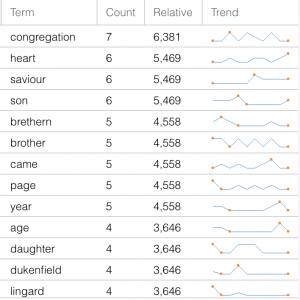 example, Document Terms showed that heart was used 18 times throughout the text and showed a trend line. This trend line is an especially helpful visualization tool in that is shows me where in the text the word is used most frequently, which allows me to ask more questions about that particular section of the document. For example, where the word heart is most frequently used, Joesph was speaking about his journey to join the congregation and how the brethren offered him lodging. Joseph’s frequent usage of “heart” shows that these kind actions deeply affected him. Overall, These tools are helpful because “amid the chaos of more frequent repetitions,” the tools allow me to see patterns that I “may have missed with close reading” (191).
example, Document Terms showed that heart was used 18 times throughout the text and showed a trend line. This trend line is an especially helpful visualization tool in that is shows me where in the text the word is used most frequently, which allows me to ask more questions about that particular section of the document. For example, where the word heart is most frequently used, Joesph was speaking about his journey to join the congregation and how the brethren offered him lodging. Joseph’s frequent usage of “heart” shows that these kind actions deeply affected him. Overall, These tools are helpful because “amid the chaos of more frequent repetitions,” the tools allow me to see patterns that I “may have missed with close reading” (191).